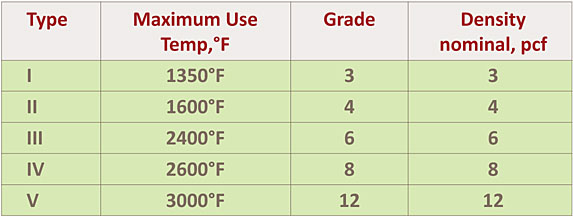Exploring Insulation Materials
High-Temperature Fiber
High-temperature fiber insulations are fibrous
insulations, varying in flexibility, density,
and composition, with or without binders. These insulation products are
available in flat sheets, rolls, boards, or loose fibers. The insulation products
are used as the thermal insulation component in the fabrication of insulation
systems for use at temperatures up to 3,000°F.
This
category of products is composed of Refractory Ceramic Fibers (RCF), including
a recently developed class generally referred to as Alkaline Earth Silicates
(AES). These AES fibers are designed to be bio-soluble (i.e., they have
enhanced in-vitro solubility characteristics that enable these products to meet
European regulatory requirements [Directive 97/69/EC] for man-made vitreous
fibers).
The
RCF products in mat and blanket form are covered in ASTM C892. Products are
classified into five types (by maximum use temperature) and five grades (by
density).

The
standard contains requirements for thermal conductivity, density, maximum use
temperature, non-fibrous (shot) content, linear shrinkage, and tensile
strength. For comparison purposes, the maximum thermal conductivity of Grade 3
material is 0.66 Btu?in/(hr?ft²?°F) at 400°F. It should be noted that not all
manufacturers of high-temperature fiber products utilize the ASTM C 892
standard for their products.
High-temperature
insulation products are often used as an alternative to fire resistance-rated shaft
enclosures. Applications include kitchen exhaust grease ducts, ventilation
ducts, stairwell pressurization ducts, smoke extraction, chemical fume exhaust
ducts, and refuse and trash chutes. They may be used to cover plastic pipe and
cables to limit flame spread and smoke generation in fire-rated air plenums.
These insulation systems are listed and labeled by nationally recognized
laboratories.
Pneumatically
applied high-temperature fibers are typically used on applications where it
would be difficult to adhere blankets to a surface. These typically are
internal surfaces, such as furnace interiors, or outer surfaces that are
convoluted and/or difficult to access, such as boiler tube walls on a
coal-fired furnace. While they are not yet covered by an industry
specification, an ASTM specification is in development.
The
composition can be described as follows: The basic types of materials are
loose, inorganic fibers (either RCF or AES) combined with a liquid, water-based
chemical binder. The fibers are made from mineral substances such as silica,
alumina, calcium, and magnesium processed from the molten state into fibrous
form. The liquid binder is made from inorganic materials: water, colloidal
silica, and less than 2% of an organic foaming agent.
The
pneumatically applied product is separated into three types based on the
chemistry and upper use temperature use limit: The liquid binder consists of a
mixture of both organic and inorganic (colloidal silica) materials, and is
typically added in sufficient quantity to provide the fibers with necessary
adhesion to the applied surface; cohesion to one another; and the required physical properties
of the installed, dry insulation. Also, this type of fiber insulation is
typically dimensionally stable with exposure to the maximum rate temperature
for the particular type (I, II, or III). When first heated above a temperature of
about 500° F, most or all of the organic binder decomposes, leaving only the
colloidal silica binder.

The surface to which pneumatically applied high-temperature
fiber insulation is applied is typically prepared with weld pins and wire mesh,
the latter being applied a distance off the surface 1 inch less than the
finished thickness. The pins and wire mesh ensure the insulation material is
firmly applied and will resist the effects of vibration and external forces.
